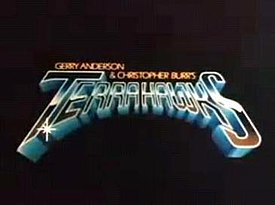Terrahawks
| Terrahawks | |
|---|---|
 |
|
| Genre | Science fiction (alien invasion), action, adventure, children's television |
| Created by |
Gerry Anderson Christopher Burr |
| Written by | Gerry Anderson Tony Barwick Donald James Trevor Lansdowne |
| Directed by | Tony Bell Tony Lenny Alan Pattillo Desmond Saunders |
| Voices of |
Denise Bryer Windsor Davies Jeremy Hitchen Anne Ridler Robbie Stevens Moya Griffiths (Kate Kestrel's singing voice only) |
| Composer(s) |
Richard Harvey Lionel Robinson Gerry Anderson Christopher Burr |
| Country of origin | United Kingdom |
| Original language(s) | English |
| No. of series | 3 |
| No. of episodes | 39 (list of episodes) |
| Production | |
| Producer(s) | Gerry Anderson Christopher Burr |
| Editor(s) | Tony Lenny |
| Camera setup | Single |
| Running time | 25 mins approx. |
| Production company(s) | Anderson Burr Pictures |
| Release | |
| Original network | ITV |
| Picture format | Film (16 and 35 mm) |
| Audio format | Mono |
| Original release | 3 October 1983 – 26 July 1986 |
Gerry Anderson & Christopher Burr's Terrahawks, usually referred to simply as Terrahawks, is a 1980s British science fiction television series produced by Anderson Burr Pictures and created by the production team of Gerry Anderson and Christopher Burr. The show was Anderson's first in over a decade to use puppets for its characters, and also his last. Anderson's previous puppet-laden TV series included Thunderbirds and Captain Scarlet and the Mysterons.
Set in the year 2020, the series followed the adventures of the Terrahawks, a taskforce responsible for protecting Earth from invasion by a group of extraterrestrial androids and aliens led by Zelda. Like Anderson's previous puppet series, futuristic vehicles and technology featured prominently in each episode.
The series is set in the year 2020, after an alien force has destroyed NASA's Mars base and Earth is under threat. A small organisation, The Terrahawks, is set up to defend the planet. From Hawknest, their secret base in South America, they develop sophisticated weapons to prepare for the battles to come.
Terrahawks was less straight-faced than any of Anderson's previous series, featuring a wry, tongue-in-cheek humour as well as dramatic jeopardy. The ensemble cast, with each member assigned a vehicle, had many similarities with Anderson's Thunderbirds, whilst the alien invasion plot was reminiscent of Captain Scarlet and the Mysterons and the live action UFO.
Prior to Terrahawks and throughout the entirety of the 1960s, Anderson's series were noted for their use of his patented Supermarionation technique, which made use of electronically augmented marionettes (the final series to use this technique was the live action/Supermarionation hybrid The Secret Service in 1969; Anderson switched to live action production beginning with 1970's UFO). In contrast, producers of Terrahawks made use of latex muppet-style hand puppets to animate the characters, in a process Anderson dubbed Supermacromation.
...
Wikipedia
